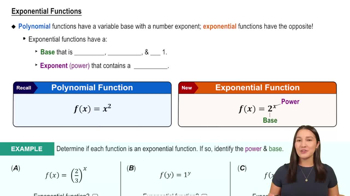Here are the essential concepts you must grasp in order to answer the question correctly.
Limits
A limit is a fundamental concept in calculus that describes the behavior of a function as its input approaches a certain value. It helps in understanding the function's behavior near points of interest, including points where the function may not be explicitly defined. In this case, evaluating the limit as x approaches 0 from the right (0+) is crucial for determining the function's behavior near that point.
Recommended video:
Exponential Functions
Exponential functions are mathematical functions of the form f(x) = a * e^(bx), where e is Euler's number (approximately 2.71828). In the given function f(x) = e^(-x) / (x(x+2)^2), the exponential component e^(-x) influences the function's growth or decay as x changes. Understanding how exponential functions behave as x approaches certain values is essential for analyzing limits.
Recommended video:
Graphing Rational Functions
Rational functions are ratios of polynomials, and their graphs can reveal important information about their limits and asymptotic behavior. The function f(x) = e^(-x) / (x(x+2)^2) is a rational function, and graphing it allows for visualizing its behavior near critical points, such as x = 0. Analyzing the graph helps in determining the limit as x approaches 0 from the right, as well as identifying any vertical or horizontal asymptotes.
Recommended video:
Graph of Sine and Cosine Function
 Verified step by step guidance
Verified step by step guidance Verified video answer for a similar problem:
Verified video answer for a similar problem:



 5:21m
5:21m